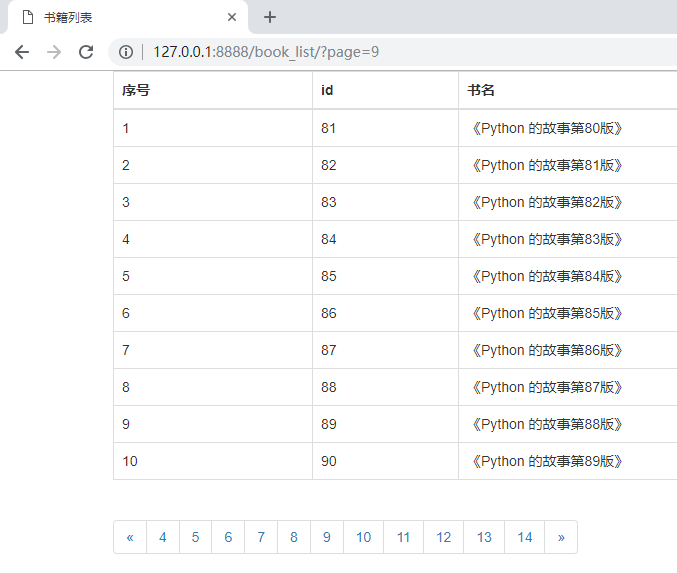这篇文章主要介绍了Python中如何实现Django页面上展示固定的页码数,具有一定借鉴价值,感兴趣的朋友可以参考下,希望大家阅读完这篇文章之后大有收获,下面让小编带着大家一起了解一下。
如果页数太多的话,全部显示在页面上就会显得很冗杂

可以在页面中显示规定的页码数
例如:

book_list.html:
<!DOCTYPE html> <html lang="en"> <head> <meta charset="UTF-8"> <title>书籍列表</title> <link rel="stylesheet" href="/static/bootstrap/css/bootstrap.min.css" rel="external nofollow" > </head> <body> <div class="container"> <table class="table table-bordered"> <thead> <tr> <th>序号</th> <th>id</th> <th>书名</th> </tr> </thead> <tbody> {% for book in books %} <tr> <td>{{ forloop.counter }}</td> <td>{{ book.id }}</td> <td>{{ book.title }}</td> </tr> {% endfor %} </tbody> </table> <nav aria-label="Page navigation"> <ul class="pagination"> <li> <a href="#" rel="external nofollow" rel="external nofollow" aria-label="Previous"> <span aria-hidden="true">«</span> </a> </li> <li> {{ page_html|safe }} </li> <li> <a href="#" rel="external nofollow" rel="external nofollow" aria-label="Next"> <span aria-hidden="true">»</span> </a> </li> </ul> </nav> </div> </body> </html>views.py:
from django.shortcuts import render from app01 import models def book_list(request): # 从 URL 中取参数 page_num = request.GET.get("page") print(page_num, type(page_num)) page_num = int(page_num) # 定义两个变量保存数据从哪儿取到哪儿 data_start = (page_num-1)*10 data_end = page_num*10 # 书籍总数 total_count = models.Book.objects.all().count() # 每一页显示多少条数据 per_page = 10 # 总共需要多少页码来显示 total_page, m = divmod(total_count, per_page) # 页面上最多展示的页码 max_page = 11 half_max_page = max_page // 2 # 页面上展示的页码的开始页 page_start = page_num - half_max_page # 页面上展示的页码的结束页 page_end = page_num + half_max_page # 如果当前页减一半比 1 小 if page_start <= 1: page_start = 1 page_end = max_page # 如果当前页加一半比总页码还大 if page_end > total_page: page_end = total_page page_start = total_page - max_page + 1 # 如果还有数据 if m: total_page += 1 all_book = models.Book.objects.all()[data_start:data_end] # 拼接 html 的分页代码 html_list = [] for i in range(page_start, page_end+1): tmp = '<li><a href="/book_list/?page={0}" rel="external nofollow" >{0}</a></li>'.format(i) html_list.append(tmp) page_html = "".join(html_list) return render(request, "book_list.html", {"books": all_book, "page_html": page_html})运行结果:

感谢你能够认真阅读完这篇文章,希望小编分享的“Python中如何实现Django页面上展示固定的页码数”这篇文章对大家有帮助,同时也希望大家多多支持亿速云,关注亿速云行业资讯频道,更多相关知识等着你来学习!
免责声明:本站发布的内容(图片、视频和文字)以原创、转载和分享为主,文章观点不代表本网站立场,如果涉及侵权请联系站长邮箱:is@yisu.com进行举报,并提供相关证据,一经查实,将立刻删除涉嫌侵权内容。